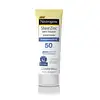Neutrogena Invisible Daily Defense Sunscreen Lotion SPF 60+ Versus Neutrogena Sheer Zinc Sunscreen Face Lotion - SPF 50
What's inside
What's inside
 Key Ingredients
Key Ingredients

 Benefits
Benefits

 Concerns
Concerns

 Ingredients Side-by-side
Ingredients Side-by-side

Butyl Methoxydibenzoylmethane 3%
UV AbsorberHomosalate 13.5%
Skin ConditioningEthylhexyl Salicylate 5%
UV AbsorberOctocrylene 10%
UV AbsorberWater
Skin ConditioningButyloctyl Salicylate
Skin ConditioningGlycerin
HumectantAlcohol Denat.
AntimicrobialSilica
AbrasiveDimethicone
EmollientAluminum Starch Octenylsuccinate
AbsorbentPolyurethane-62
Phenoxyethanol
PreservativePentylene Glycol
Skin ConditioningSodium Acryloyldimethyltaurate/Vp Crosspolymer
Emulsion StabilisingAcrylates/Dimethicone Copolymer
Skin ConditioningGlyceryl Stearate
EmollientChlorphenesin
AntimicrobialStyrene/Acrylates Copolymer
Parfum
MaskingMenthyl Lactate
MaskingTocopheryl Acetate
AntioxidantDisodium EDTA
Trideceth-6
EmulsifyingChrysanthemum Parthenium Flower/Leaf/Stem Juice
AntioxidantSodium Hydroxide
BufferingCI 19140
Cosmetic ColorantCI 16035
Cosmetic ColorantButyl Methoxydibenzoylmethane 3%, Homosalate 13.5%, Ethylhexyl Salicylate 5%, Octocrylene 10%, Water, Butyloctyl Salicylate, Glycerin, Alcohol Denat., Silica, Dimethicone, Aluminum Starch Octenylsuccinate, Polyurethane-62, Phenoxyethanol, Pentylene Glycol, Sodium Acryloyldimethyltaurate/Vp Crosspolymer, Acrylates/Dimethicone Copolymer, Glyceryl Stearate, Chlorphenesin, Styrene/Acrylates Copolymer, Parfum, Menthyl Lactate, Tocopheryl Acetate, Disodium EDTA, Trideceth-6, Chrysanthemum Parthenium Flower/Leaf/Stem Juice, Sodium Hydroxide, CI 19140, CI 16035
Zinc Oxide 21.6%
Cosmetic ColorantWater
Skin ConditioningC12-15 Alkyl Benzoate
AntimicrobialOctyldodecyl Citrate Crosspolymer
HumectantStyrene/Acrylates Copolymer
Phenyl Trimethicone
Skin ConditioningCetyl PEG/PPG-10/1 Dimethicone
EmulsifyingDimethicone
EmollientPolyhydroxystearic Acid
EmulsifyingGlycerin
HumectantEthyl Methicone
EmollientCetyl Dimethicone
EmollientSilica
AbrasiveColloidal Oatmeal
AbsorbentTocopheryl Acetate
AntioxidantChrysanthemum Parthenium Flower/Leaf/Stem Juice
AntioxidantGlyceryl Behenate
EmollientPhenethyl Alcohol
MaskingCaprylyl Glycol
EmollientCetyl Dimethicone/Bis-Vinyldimethicone Crosspolymer
EmollientAcrylates/Dimethicone Copolymer
Skin ConditioningSodium Chloride
MaskingPhenoxyethanol
PreservativeChlorphenesin
AntimicrobialZinc Oxide 21.6%, Water, C12-15 Alkyl Benzoate, Octyldodecyl Citrate Crosspolymer, Styrene/Acrylates Copolymer, Phenyl Trimethicone, Cetyl PEG/PPG-10/1 Dimethicone, Dimethicone, Polyhydroxystearic Acid, Glycerin, Ethyl Methicone, Cetyl Dimethicone, Silica, Colloidal Oatmeal, Tocopheryl Acetate, Chrysanthemum Parthenium Flower/Leaf/Stem Juice, Glyceryl Behenate, Phenethyl Alcohol, Caprylyl Glycol, Cetyl Dimethicone/Bis-Vinyldimethicone Crosspolymer, Acrylates/Dimethicone Copolymer, Sodium Chloride, Phenoxyethanol, Chlorphenesin
 Reviews
Reviews

Ingredients Explained
These ingredients are found in both products.
Ingredients higher up in an ingredient list are typically present in a larger amount.
This polymer has film-forming properties and helps leave behind a soft film on the skin with oxygen permeability.
That's why you'll most likely find this in sunscreen formulations.
Chlorphenesin is a synthetic preservative. It helps protect a product against bacteria in order to extend shelf life. In most cases, Chlorphenesin is paired with other preservatives such as phenoxyethanol and caprylyl glycol.
Chlorphenesin is a biocide. This means it is able to help fight the microorganisms on our skin. It is also able to fight odor-releasing bacteria.
Chlorphenesin is soluble in both water and glycerin.
Studies show Chlorphenesin is easily absorbed by our skin. You should speak with a skincare professional if you have concerns about using Chlorphenesin.
Learn more about ChlorphenesinChrysanthemum Parthenium Flower/Leaf/Stem Juice is an antioxidant.
Dimethicone is a type of synthetic silicone created from natural materials such as quartz.
What it does:
Dimethicone comes in different viscosities:
Depending on the viscosity, dimethicone has different properties.
Ingredients lists don't always show which type is used, so we recommend reaching out to the brand if you have questions about the viscosity.
This ingredient is unlikely to cause irritation because it does not get absorbed into skin. However, people with silicone allergies should be careful about using this ingredient.
Note: Dimethicone may contribute to pilling. This is because it is not oil or water soluble, so pilling may occur when layered with products. When mixed with heavy oils in a formula, the outcome is also quite greasy.
Learn more about DimethiconeGlycerin is already naturally found in your skin. It helps moisturize and protect your skin.
A study from 2016 found glycerin to be more effective as a humectant than AHAs and hyaluronic acid.
As a humectant, it helps the skin stay hydrated by pulling moisture to your skin. The low molecular weight of glycerin allows it to pull moisture into the deeper layers of your skin.
Hydrated skin improves your skin barrier; Your skin barrier helps protect against irritants and bacteria.
Glycerin has also been found to have antimicrobial and antiviral properties. Due to these properties, glycerin is often used in wound and burn treatments.
In cosmetics, glycerin is usually derived from plants such as soybean or palm. However, it can also be sourced from animals, such as tallow or animal fat.
This ingredient is organic, colorless, odorless, and non-toxic.
Glycerin is the name for this ingredient in American English. British English uses Glycerol/Glycerine.
Learn more about GlycerinPhenoxyethanol is a preservative that has germicide, antimicrobial, and aromatic properties. Studies show that phenoxyethanol can prevent microbial growth. By itself, it has a scent that is similar to that of a rose.
It's often used in formulations along with Caprylyl Glycol to preserve the shelf life of products.
Silica, also known as silicon dioxide, is a naturally occurring mineral. It is used as a fine, spherical, and porous powder in cosmetics.
Though it has exfoliant properties, the function of silica varies depending on the product.
The unique structure of silica enhances the spreadability and adds smoothness, making it a great texture enhancer.
It is also used as an active carrier, emulsifier, and mattifier due to its ability to absorb excess oil.
In some products, tiny microneedles called spicules are made from silica or hydrolyzed sponge. When you rub them in, they lightly polish away dead skin layers and enhance the penetration of active ingredients.
Learn more about SilicaWe don't have a description for Styrene/Acrylates Copolymer yet.
Tocopheryl Acetate is AKA Vitamin E. It is an antioxidant and protects your skin from free radicals. Free radicals damage the skin by breaking down collagen.
One study found using Tocopheryl Acetate with Vitamin C decreased the number of sunburned cells.
Tocopheryl Acetate is commonly found in both skincare and dietary supplements.
Learn more about Tocopheryl AcetateWater. It's the most common cosmetic ingredient of all. You'll usually see it at the top of ingredient lists, meaning that it makes up the largest part of the product.
So why is it so popular? Water most often acts as a solvent - this means that it helps dissolve other ingredients into the formulation.
You'll also recognize water as that liquid we all need to stay alive. If you see this, drink a glass of water. Stay hydrated!
Learn more about Water